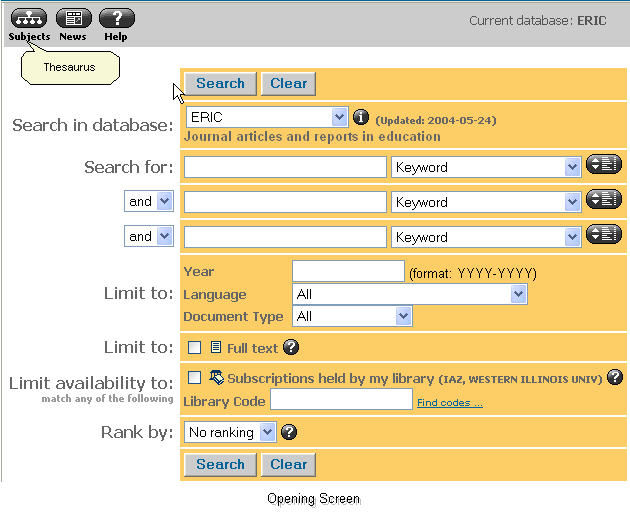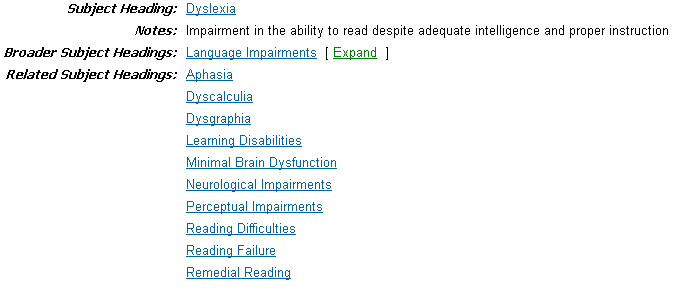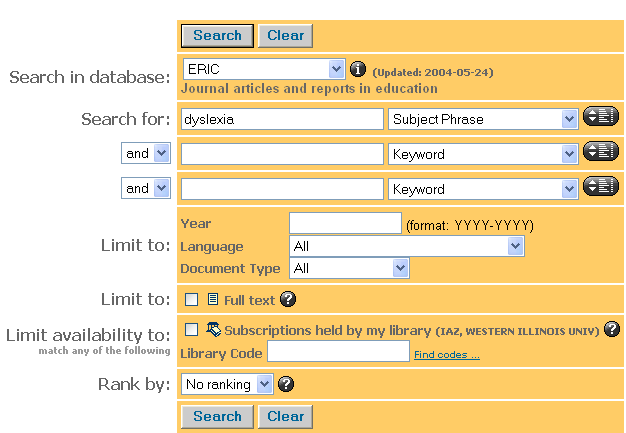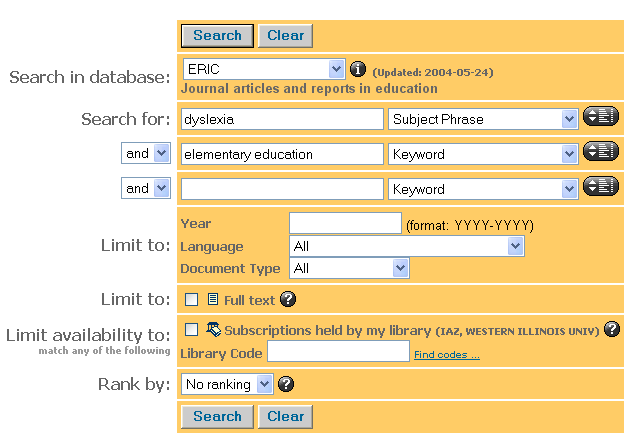| ERIC is a database historically
produced by the U.S. Department of education. I say, "historically," because
the Bush administration has decided to outsource ERIC. This is supposed to
occur in Fall 2004. So what I am telling you today about searching ERIC may
not be true six months from now.
This site will keep
you informed as to what is happening with ERIC. |
| |
| Next: There are a number of
versions of ERIC that you can search. There is the First Search version, the
EBSCO version, and the free version the government provides. Each version
contains the same data, but presents it a bit differently and with slightly
different functionality. We're going to look at the First Search version. |
| |
| Let's get started. Click
here
to open the First Search version of ERIC. |
| |
| Below is the opening screen in the
First Search version of ERIC. |
| |
|
 |
| |
Note that the ERIC Thesaurus
is located under the heading Subjects in the upper left hand corner
of the screen. The Thesaurus is an excellent place to begin your research.
So click on the Subjects icon
 . . |
| |
Type in "dyslexia" and click on
Find.
 |
|
|
| |
| You should see
what appears in the screen to the right. If you click on Dyslexia,
First Search will run a "subject phrase" search. If you click on Expand,
First Search will give you more search terms. Click on Expand. |
 |
| |
 |
| |
| Clicking on any of the terms will
initiate a subject or subject phrase search. Note that the subect term,
Language Impairments, can itself be expanded. Let's click on
Dyslexia to see what a search looks like. |
| |
| |
 |
|
| |
| Note that we get more than a
thousand results--way too many to handle efficiently. There a number of ways
to handle the results. Click on the Searching tab to go to the
main search screen. |
| |
| |
|
 |
| |
| From this screen we can add
new search terms, we can limit the results by type of document; by year, by
subscriptions held in WIU's library, etc. For example, below I added the
terms "elementary education." If you run this search, you will get 487
results--still too many. |
|
|
 |
| |
| |
| Below I added a further
restriction, asking that the database only give me those items found between
2000-2004. This produces 87 results, which is about right. |
|
 |
| |
| |
| Here are some of the results. They
are a mixed bag of ERIC Documents, Journal articles--full text and not.
What is an ERIC Document? ERIC documents are not journal articles. They are
reports of various kinds (from all levels of education: local, state,
federal), conference papers, budgets, whole books, etc. You can tell right
away if something is an ERIC Document by Accession number, which will begin
with an ED. Note the first result below has an Accession number
beginning with an ED. Journal articles' accession numbers begin with EJ.
Be aware that some faculty do not allow the use of ERIC Documents for
research papers, literature reviews, etc. So, be sure to ask before
starting your research. We have access to most ERIC Documents either in
microfiche or online. To view a document on microfiche, take its accession
number to the third floor and tell the people at the periodicals desk
you need help finding an ERIC document on microfiche. To learn how to
access ERIC documents online go
here. |
 |
|
| |
|
Retrieving journal articles. |
| |
| Let me start by suggesting that you
set the search menu so that you only get journal articles no ERIC documents.
That way you don't have to worry whether you're dealing with the one or the
other. To do this set the DOCUMENT TYPE delimiter to
Journal. The search below has been set up so that it will only locate
journal articles about dyslexia. The search produces 850+ hits, which is
still too many, but we can reduce that number by adding additional search
terms or restricting the number of years, etc. |
| |
|
 |
| |
| The search above has been refined
by adding elementary education which reduces the number of hits to
160+. This is manageable. |
| |
|
 |
| |
|
|
Let's consider the results below.
Note that the first result is available full text in two formats, PDF and
HTML. When it's available, choose HTML as it uses less bandwidth and will be
much easier to print. Note that the second result has an icon
 indicating that
WIU subscribes (or did at one time subscribe) to the journal in print. This
means that there is a pretty good chance you can get this article in print
on the third floor. It may also reside full text in another database,
InfoTrac, for instance. So, we need to find the answers to these questions.
The way to do this is to use the
PERIODICALS HOLDINGS LIST, a list of all the journals, both in print and
in digital format, that WIU subscribes to. The third article does not
have an icon. Nonetheless, we ought to search the PERIODICALS HOLDINGS LIST
because we might have a digital subscription. It turns it out that we do
have a digital subscription to READING AND WRITING. Click
here
for a tutorial showing how to do this. indicating that
WIU subscribes (or did at one time subscribe) to the journal in print. This
means that there is a pretty good chance you can get this article in print
on the third floor. It may also reside full text in another database,
InfoTrac, for instance. So, we need to find the answers to these questions.
The way to do this is to use the
PERIODICALS HOLDINGS LIST, a list of all the journals, both in print and
in digital format, that WIU subscribes to. The third article does not
have an icon. Nonetheless, we ought to search the PERIODICALS HOLDINGS LIST
because we might have a digital subscription. It turns it out that we do
have a digital subscription to READING AND WRITING. Click
here
for a tutorial showing how to do this. |
| |
|
 |
|
|
USING INTER LIBRARY LOAN |
| |
If an article is not available in
our collection either in print or digitally, then you can Inter Library Loan
to get a copy. To do this open up the citaion of the article and click on
the  icon.
Fill out the form. It usually takes 10 business days for an article to
arrive. You may make 5 requests a day. There is usually no charge. If there
should be a charge, you will always be given the option to decline. icon.
Fill out the form. It usually takes 10 business days for an article to
arrive. You may make 5 requests a day. There is usually no charge. If there
should be a charge, you will always be given the option to decline. |
| |
|
USING SORT |
| |
|
The default sort for ERIC is reverse chronological order
by publication date. However, if you have less than 250 results you can sort
other ways. Why do this? Well, if you sort by journal title, then, you will
have all the articles from the same journal together. This is particularly
useful if you have to go upstairs, where the journals are shelved in
alphabetical order. You invoke sort from the results list by clicking
on the  icon. When the menu comes up select SOURCE, which is what the database calls
journals.
icon. When the menu comes up select SOURCE, which is what the database calls
journals. |
| |
|
 |
| |
|
Here and
here and
here are more examples of ERIC searches. |
|
|
|
| If you need help e-mail me,
William Thompson. |
|












![]() icon. When the menu comes up select SOURCE, which is what the database calls
journals.
icon. When the menu comes up select SOURCE, which is what the database calls
journals. ![]()